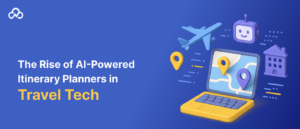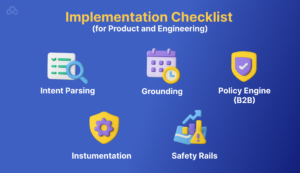Introduction

Trip planning used to mean tabs on tabs: maps, blogs, price trackers, and a trusty spreadsheet. Now? You can ask a system for a four-day Tokyo plan with kid-friendly ramen spots, a museum near your hotel, and a late-flight buffer, and it does the stitching for you. This isn’t a future teaser. It’s shipping, from consumer apps to corporate travel software used by global teams. Booking.com’s AI Trip Planner rolled out new capabilities for property-specific Q&A; Expedia introduced “Romie,” an AI travel buddy made by a travel technology company with travel booking solutions as well as travel booking software; and Google trialed trip planning inside Search Labs. All three moves confirm where the market is headed: conversational planning as the front door to booking .
And it’s not just Western markets. India’s largest OTA, MakeMyTrip, launched a multilingual GenAI assistant that plans and books trips in English and Hindi, a strong signal that localized, voice-friendly planning is going mainstream.
What “AI-powered itineraries” mean for a travel technology company
At a high level, modern itinerary planners combine:
- Large language models for conversational intent capture (“3 days in Kyoto with a toddler, no long walks”).
- Recommendation graphs built from reviews, booking data, and first-party signals to rank POIs, eateries, tours, and hotels.
- Constraint engines for time windows, opening hours, transfers, and weather, paired with live inventory and prices.
- Personalization layers: account history, loyalty tiers, and, on the enterprise side, policy and approval rules.
Consumer apps use this to turn a vague prompt into a bookable plan. TripAdvisor’s “Trips” lets you build or co-create with AI; Booking.com now supports follow-up questions like “rooftop bar + canal view” at a specific hotel. The travel technology company Expedia’s travel booking software has newer AI features even meet travelers where they browse, on social, by letting users share an Instagram Reel and get a tailored plan back.
Enterprise platforms lean harder on policy, duty-of-care, and audit. Navan’s Ava assistant handles self-serve support and booking changes inside a managed program; the travel technology company recently opened up more of that AI stack to customers building their own workflows. If you’re a travel technology company servicing corporates, this is the bar.
Why this is accelerating now
Three forces lined up:
- Better models + tighter data loops. LLMs got good at multi-turn directions; travel firms brought proprietary availability, reviews, and pricing into the mix. Booking.com and TripAdvisor both say the goal isn’t “chat,” it’s decisioning, fewer clicks to the right hotel, at the right time.
- Platform distribution. Google tested trip planning directly in Search; Expedia tied AI planning to Instagram content. If discovery lives on social and search, itinerary planners need to plug in at those edges.
- Corporate mandates. Finance teams want compliance by default. AI planners as travel booking solutions that understand route options, fare families, caps, carbon limits, and approvals are winning RFPs against legacy travel booking software. Navan’s adoption curve with Ava is a useful bellwether.
What’s live today: snapshots by segment
Consumer OTAs & Metas
- Booking.com: conversational search + property-specific Q&A inside the app.
- TripAdvisor: “Trips” and an AI builder to jump-start day plans; improved collaboration.
- Expedia: “Romie” assistant plus Trip Matching, send a Reel, get an itinerary; very on-trend for social discovery.
- Google: trip planning trials in Search Labs signal intent to keep users inside search for the early plan.
Corporate travel
-
Navan (TripActions): Ava handles a meaningful share of support and booking chat, with policy and card data in context.
-
Regional leaders: MakeMyTrip’s multilingual assistant shows how rapid localization can expand TAM in domestic markets, an angle enterprise TMCs should watch for traveler adoption patterns.
Where ROI shows up (and how to prove it)
AI itinerary planners should move four numbers you already track:
-
Conversion , Fewer steps from idea → cart → payment. Expect uplift where the assistant reduces filter fatigue and filler clicks. Booking.com’s property Q&A is a direct play here.
-
Attachment , More ancillaries (bags, seats, cars, tours) when the plan naturally surfaces them. Expedia’s content-to-commerce via Trip Matching targets exactly this.
-
Service deflection , On corporate programs, assistants triage “can I change my flight?” or “what’s the policy?” before agent hand-off. Navan cites meaningful chat coverage by Ava.
-
Policy/Compliance , In B2B, compliant itineraries by default drive savings without extra friction.
Build vs buy: options for a travel technology company
If you’re a travel technology company deciding how to add AI planning:
-
Embed a general LLM (OpenAI, Anthropic) + retrieval layer for your content. Fastest to market; you’ll spend time on guardrails.
-
Verticalized partners offering itinerary APIs; quicker compliance and scheduling logic but less differentiation.
-
In-house orchestration across booking engines, content stores, and support tools. Harder, but you own the secret sauce.
Table 1 , Capability checklist (for RFPs and roadmaps)
|
Capability |
Consumer OTA |
Corporate TMC |
Why it matters |
|
Property-specific Q&A |
✅ |
➖ |
Eliminates booking friction. |
|
Multi-day routing w/ hours |
✅ |
✅ |
Prevents impossible day plans; reduces churn. |
|
Policy-aware suggestions |
➖ |
✅ |
Enforces budgets and approvals automatically. |
|
Social/search ingest |
✅ |
➖ |
Converts discovery into booked trips. |
|
Live inventory & ancillaries |
✅ |
✅ |
Unlocks attachment revenue. |
|
Agent hand-off/co-pilot |
➖ |
✅ |
Limitations you should plan for (not dodge)
-
Hallucinations & stale data. Tie responses to source-of-truth inventory and hours; cite the origin when possible. Google’s slow walk on its own planner shows how tricky quality is at scale.
-
Explainability. When the model suggests a 07:10 departure with a tight layover, show why: price, policy, or traveler preference.
-
Privacy & governance. Corporate buyers will ask where prompts go, how long you retain them, and how PII is masked.
-
Localization beyond translation. MakeMyTrip’s Hindi support is a reminder: voice and regional discovery patterns matter.
Mini case notes
-
City break, three nights: A TripAdvisor-style builder turns four broad preferences into a walkable loop with bookable POIs and a dinner near the hotel; the user edits day two and swaps in a cooking class. (This pattern, AI first draft, human edits, is common and sticky.)
-
Corporate offsite, 42 travelers: An Ava-like assistant quotes flights inside policy, pre-fills approvals, and routes edge cases to an agent; finance sees fewer post-trip exceptions.
-
Inspiration to booking via social: A Reel of Kyoto’s Fushimi Inari is shared to Expedia’s Trip Matching; the user gets a 48-hour plan with hotels within walking distance and a late-flight buffer. Attachment: rail pass + airport transfer.
Implementation checklist (for product and engineering)

-
Intent parsing: Collect the five essentials early, date/time windows, party size, mobility needs, budget band, and hotel location bias.
-
Grounding: Connect the model to live availability, pricing, and opening hours; fall back gracefully when data is thin.
-
Policy engine (B2B): Keep rules explainable; expose “why not allowed” in plain language.
-
Instrumentation: Track conversion, itinerary edits, deflection, and NPS on assistant interactions.
-
Safety rails: Time-aware routing, transfer buffers, and weather checks for outdoor items.
Conclusion: how a travel technology company turns chat into committed trips
AI itinerary planners aren’t replacing discovery; they’re compressing it into one guided flow that starts in chat (or search, or social) and ends in a cart. For a travel technology company, the play is straightforward: ground the model in your data, design for edits (not perfection), and wire the plan to booking. In consumer, that means faster decisions and higher attachment. In corporate, it means compliant trips with fewer human touchpoints, and less noise hitting your agents. The winners will treat AI planning as product, not a demo.
Technical FAQs
1. How do we stop hallucinated POIs and hours?
Use retrieval-augmented generation with a fresh index of POIs, hours, and closures; expire responses quickly and show “last updated” stamps. Where quality is critical (e.g., visa rules), render canonical links in the UI. Google’s go-slow posture underscores the need for grounded answers.
2. Can we measure ROI beyond conversion?
Yes. Track itinerary edit rate (good planners need fewer heavy edits), ancillary attach, and service deflection. Travel booking solutions will help. For B2B, add policy compliance at first quote, not post-trip audit. Navan’s assistant coverage shows the deflection story clearly.
3. How should corporate travel software integrate an AI planner?
Embed it where travelers already make decisions: calendar holds, Slack/Teams, mobile apps. Enforce policy in the suggestion stage. Hand-off to agents with full context to reduce handle time. This is where travel technology company booking solutions differentiate in RFPs.
4. What about multilingual, voice-first planning?
Prioritize your top languages and consider ASR (automatic speech recognition) tuned for place names. MakeMyTrip demonstrates real traction with Hindi + English, which is a strong template for other multi-lingual markets.
5. Are social and search integrations worth the effort?
If your audience discovers on those channels, yes. Expedia’s Instagram connector and Google’s Search Labs planning both point to a “plan where you are” future. Build small: one ingest pipeline, one clear use case, then expand.
Do you like to read more educational content? Read our blogs at Cloudastra Technologies or contact us for business enquiry at Cloudastra Contact Us.